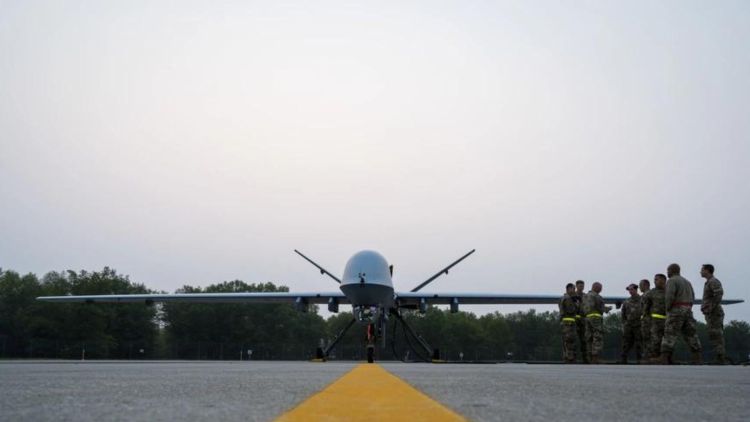Last September, a U.S. Air Force MQ-9 drone crashed into the sea in the Middle East due to a combination of pilot errors and poor supervision.
This accident, which destroyed a $26.1 million aircraft, had not been disclosed until now. It was one of three unrelated Class A mishaps in the Air Force within five days, highlighting a troubling trend in mishap rates.
The Incident
The MQ-9 was launched by a Launch and Recovery Element in Africa and was controlled by a crew from the 162nd Attack Squadron at Springfield-Beckley Air National Guard Base, Ohio.
The MQ-9 Reaper is an armed, multi-mission, medium-altitude, long-endurance remotely piloted aircraft that is employed primarily as an intelligence-collection asset and secondarily against dynamic execution targets. (U.S. Air Force photo by Senior Airman Cory D. Payne / DVIDS)
The mission took place within the U.S. Central Command’s area of responsibility. After completing the mission, the drone was returning to Africa when an electrical system malfunction occurred.
The pilot correctly identified the issue as a “Starter-Generator failure,” but then made several mistakes by not following the malfunction checklist. The operations supervisor further complicated the situation, causing confusion about the malfunction’s severity.
If the starter generator fails, batteries can temporarily power SATCOM and other systems, allowing the crew to set a new emergency mission profile to return to base.
The pilot mistakenly calculated the aircraft’s flight time due to a dual generator failure. As the pilot was tinkering through the checklist, the operations supervisor advised a generator reset—a maneuver only recommended if the plane was deemed unrecoverable. This caused further confusion about the malfunction’s nature.
Miscommunication and Decision Making
Miscommunication played a significant role in the mishap. Initially, the crew decided to attempt a crash landing at a forward operating base.
However, the operations supervisor instructed the pilot to start climbing and to immediately deploy the landing gear, which slowed the aircraft and reduced its capability to reach the base on what little power it had. They then decided to crash the MQ-9 into the water near a U.S. vessel.
The pilot guided the drone to a water patch near the vessel and set it to loiter there. Without an emergency mission set, the plane loitered until its fuel ran out, which took over two hours. The wreckage bulk was not recovered.
The investigation revealed that the pilot and the supervisor were primarily at fault. The pilot failed to follow the electrical systems malfunction checklist, which would have confirmed the starter generator as the issue and ensured the emergency mission profile was set correctly.
The operations supervisor, who was the main communicator with the Launch and Recovery Element and the Combined Air Operations Center, caused confusion about the malfunction and the aircraft’s recoverability. The pilot showed poor knowledge of the electrical system and made multiple errors during a training simulation, leading to required retraining.
The operations supervisor provided excessive advice and direction, failing to follow the malfunction checklist correctly.
Despite being an evaluator pilot, the supervisor focused too quickly on a crash landing rather than assessing the malfunction’s source and considering a standard recovery. This overbearing approach only added to the pilot’s confusion and stress, which contributed to the mishap.
Training and Preparedness
The report highlighted the need for better training and preparedness among MQ-9 crews. The pilot’s lack of experience and poor understanding of the electrical systems played a critical role in the crash.
The investigation noted that during a training simulation, the pilot was slow to recognize and act in emergency situations, made frequent errors and omissions, and demonstrated below-average performance. This lack of proficiency underscores the importance of rigorous and continuous training to ensure pilots can handle emergencies effectively.
Moreover, the operations supervisor’s role in the mishap indicates a need for improved leadership and communication skills. Supervisors must provide clear, concise, and accurate guidance, especially during emergencies.
The supervisor’s failure to follow the checklist and the inclination to crash land prematurely contributed significantly to the crash. This incident suggests that even experienced personnel need ongoing training and evaluation to maintain their effectiveness.
Recent MQ-9 Mishaps
The Air Force has faced several MQ-9 mishaps over the past 18 months, raising concerns about the reliability and safety of these drones. A contractor crashed a drone in California last January 2023, causing $16 million in damages.
Airmen from the 386th EAMXS are responsible for maintaining the airframe and ensuring the remotely piloted aircraft remains ready to complete its close air support and intelligence, surveillance, and reconnaissance mission. (U.S. Air Force photo by Senior Airman Isaiah J. Soliz / DVIDS)
In May 2023, another MQ-9 crashed in Africa due to engine failure, resulting in its destruction. In September 2023, a contractor died after walking into an MQ-9’s propeller while ground testing was ongoing. Additionally, in January 2024, an MQ-9 crashed in Poland, marking another significant loss.
These incidents highlight a troubling pattern of mishaps involving MQ-9 drones. While some of these accidents can be attributed to mechanical failures or human error, the frequency and severity of these incidents suggest systemic issues that need to be addressed. The Air Force must take proactive measures to improve training, maintenance, and operational procedures to prevent future mishaps.
Moving Forward
The MQ-9 crash in September 2023 serves as a stark reminder of the complexities and challenges associated with operating advanced unmanned aerial vehicles.
The investigation’s findings underscore the need for comprehensive training, effective communication, and rigorous adherence to operational procedures. As the Air Force continues to rely on MQ-9 drones for a wide range of missions, ensuring the safety and reliability of these aircraft is paramount.
Moving forward, the Air Force should implement the recommendations from the investigation report to enhance training and preparedness among MQ-9 crews.
This includes revising training programs to focus on emergency procedures, improving communication protocols, and conducting regular evaluations to ensure that both pilots and supervisors are equipped to handle complex and high-pressure situations.
By addressing the root causes of the recent mishaps and implementing these changes, the Air Force can reduce the risk of future accidents and maintain the operational effectiveness of its MQ-9 fleet. Ensuring the safety and reliability of these drones is not just about protecting valuable assets but also about preserving the lives of those who operate and support these missions.
__
Disclaimer: SOFREP utilizes AI for image generation and article research. Occasionally, it’s like handing a chimpanzee the keys to your liquor cabinet. It’s not always perfect and if a mistake is made, we own up to it full stop. In a world where information comes at us in tidal waves, it is an important tool that helps us sift through the brass for live rounds.



